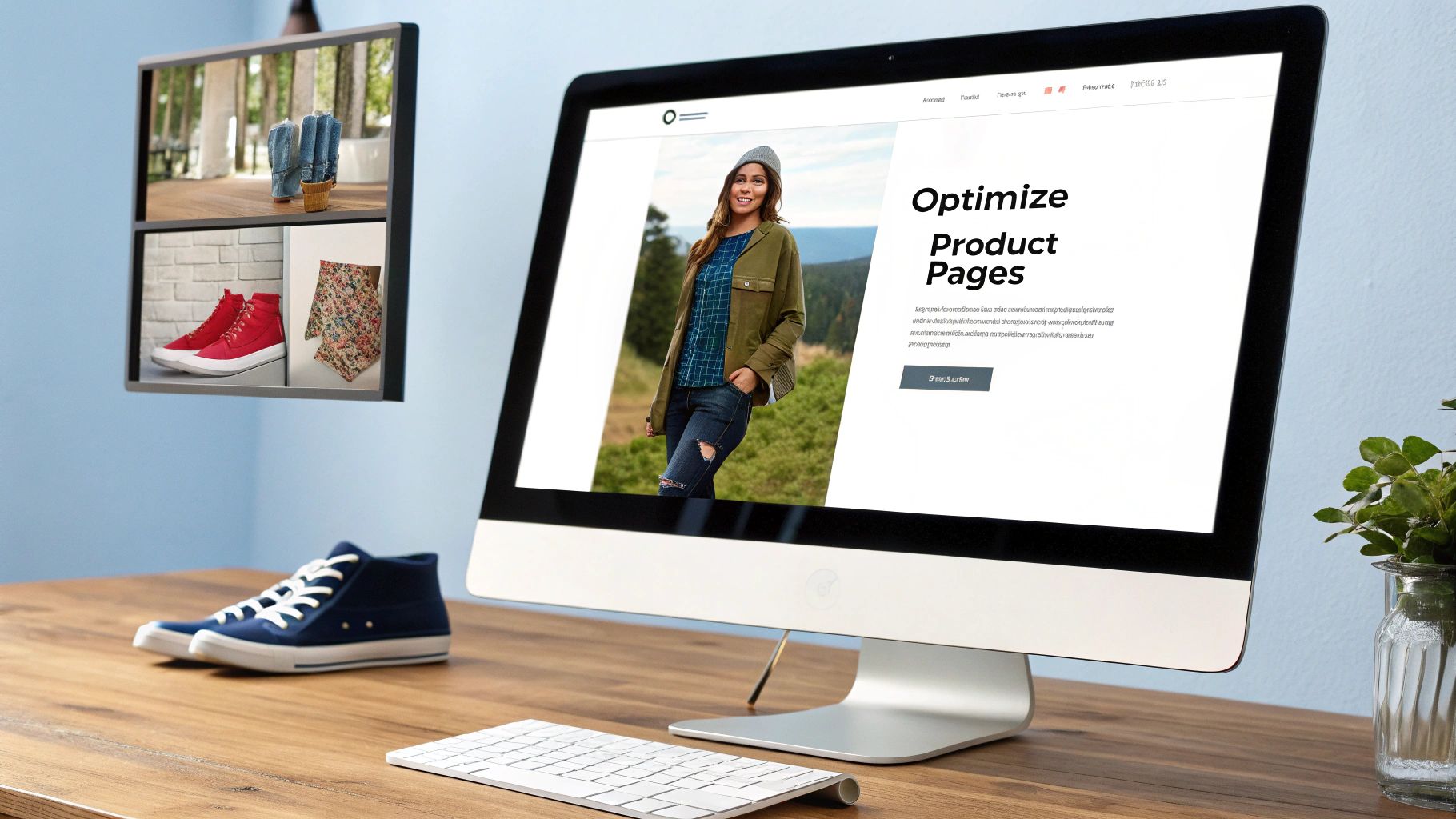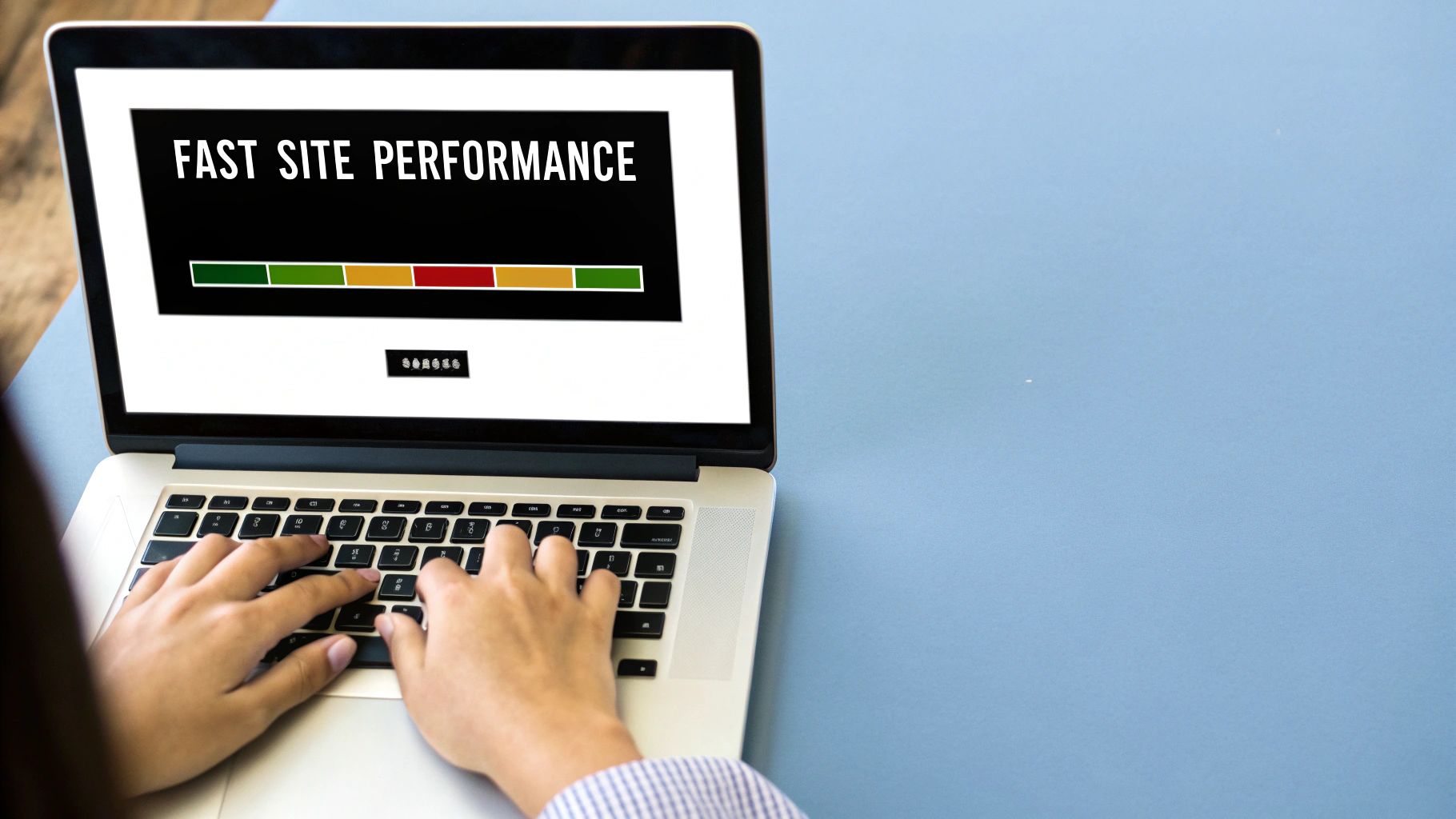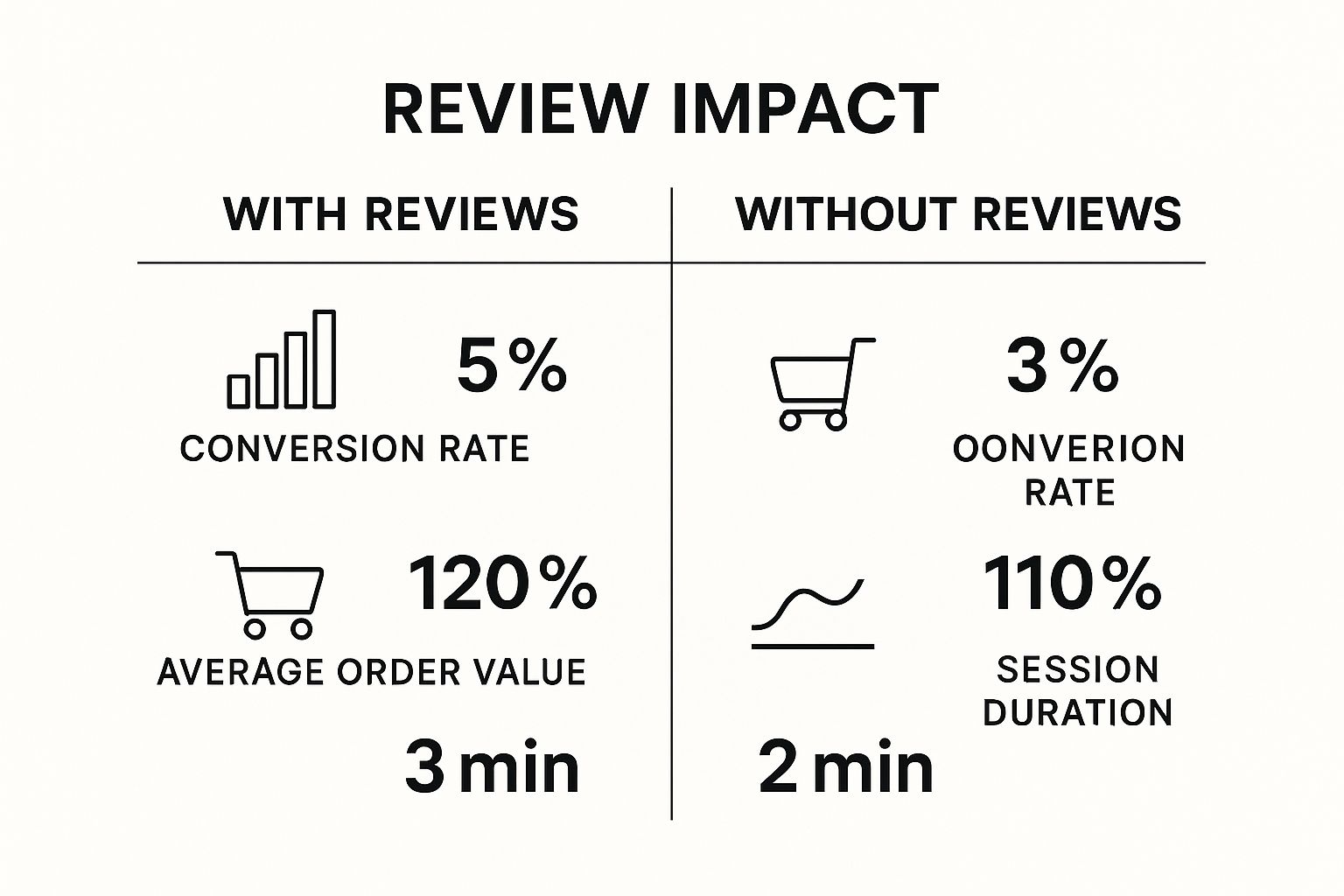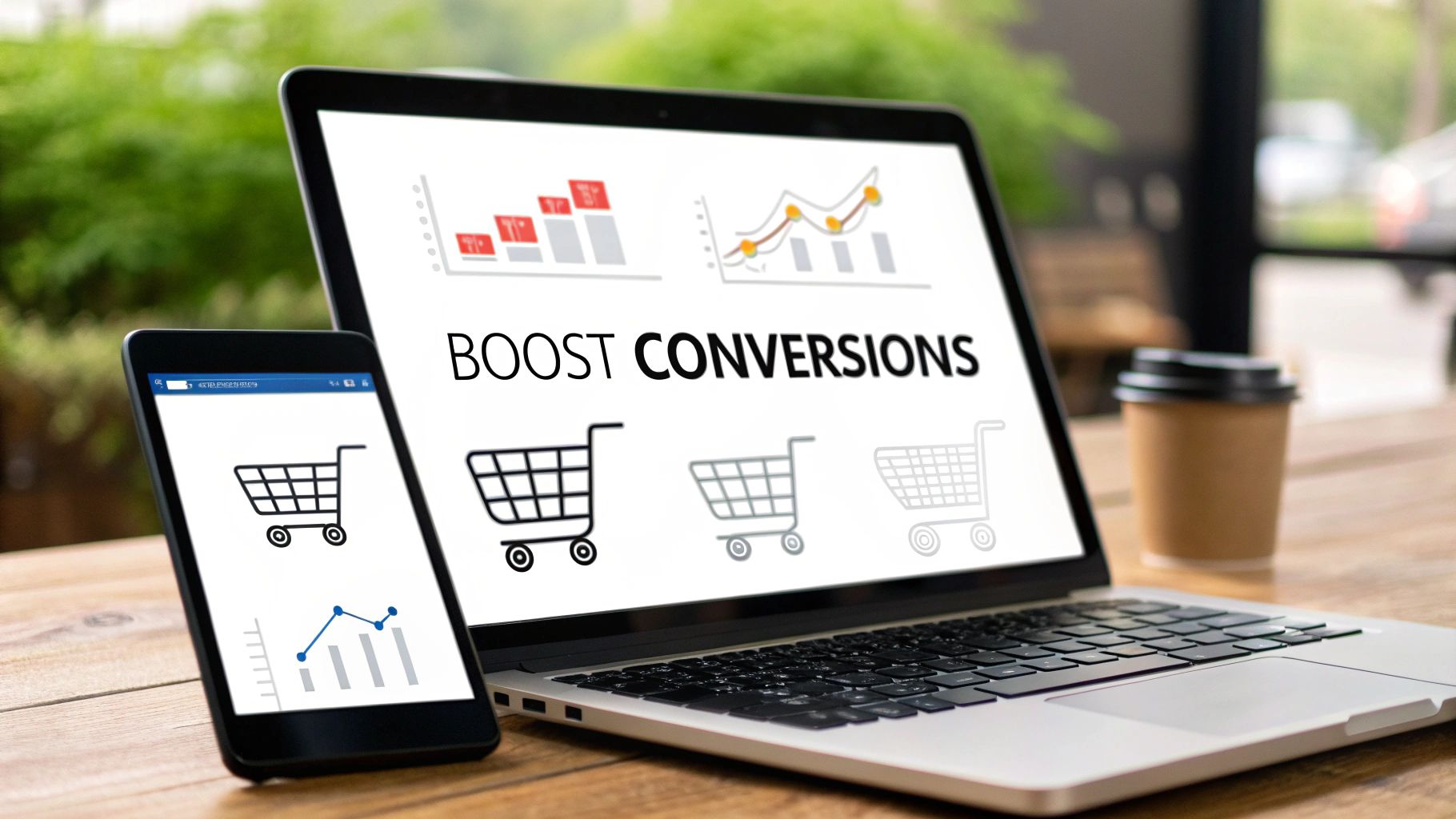You’ve poured blood, sweat, and a serious marketing budget into getting traffic to your store, but the sales just don’t match the effort. From our experience with over 500 Shopify stores, we know this feeling all too well—it’s like trying to fill a leaky bucket. This is the central problem of improving ecommerce conversion rates, and it's a frustrating one.
In this playbook, you'll learn exactly how to find the biggest leaks in your sales funnel and implement the proven, data-backed strategies we use to help brands turn more browsers into buyers.
What is a Good Ecommerce Conversion Rate, Really?
That leaky bucket isn't just a metaphor; it's the statistical reality for most online brands. Getting people to your site is one thing, but the real work begins when you have to convince them to actually click "buy." Every visitor who leaves without purchasing isn't just a missed opportunity—it's real, tangible revenue walking out the door.
This is why you have to know your numbers. Without a benchmark, you're just guessing. Data shows the global average ecommerce conversion rate hovers around 2.7%. This number shifts quite a bit depending on where you are, with Great Britain pulling a strong 4.1% while the United States sits closer to the average at 2.5%. It's worth diving into these conversion rate optimization statistics to see how your store really stacks up.
The big takeaway here is pretty stark: for every 100 visitors who land on your site, about 97 of them will leave without buying anything. That might sound discouraging, but we see it as your single biggest opportunity for growth.
Why Small Wins Lead to a Massive Impact
One of the biggest mistakes we see is brands chasing huge, unrealistic conversion goals right out of the gate. The strategy that consistently delivers the best results for our clients is a relentless focus on small, incremental gains.
Let's break down the math on why this is so powerful:
- More Revenue, Same Traffic: Lifting your conversion rate from 2% to just 2.5% isn't a small jump—it’s a 25% increase in sales from the exact same traffic you're already getting.
- Better ROAS: Your ad spend suddenly becomes much more efficient. You’re making more money from the customers you already paid to acquire. Return on Ad Spend (ROAS) is a simple measure of how much revenue you earn for every dollar you spend on advertising.
- Compounding Growth: These small, data-backed tweaks build on each other, creating a much stronger, more profitable business over time.
In this guide, we’re going to give you the exact playbook to start plugging those leaks. You’ll learn how to find the biggest points of friction on your site and implement proven tactics to turn more of those window shoppers into loyal customers.
How to Conduct a Conversion Audit and Find Your Leaks
Before you even think about changing a button color or A/B testing a headline, you have to play detective. A common mistake we see is brands blindly copying what their competitors are doing, assuming it will work for them. It rarely does. Improving your conversion rate isn't about guesswork or following trends; it's about diagnosis.
You need to find out where your bucket is leaking before you can even begin to patch the holes.

The good news? This doesn't require a team of data scientists. With a couple of free tools and a bit of focused effort, you can uncover exactly where you’re losing potential customers. The whole point is to pinpoint those moments of hesitation, confusion, or frustration that are killing your sales.
Pinpoint Funnel Drop-Off with Analytics
Your first stop should always be your analytics dashboard—for most stores, that's Google Analytics. You’re hunting for reports like “Behavior Flow” or the newer “Funnel Exploration.” These reports are gold because they literally draw you a map of the paths people take through your store, and more importantly, they show you the exact pages where they give up and leave.
Keep a close eye on the drop-offs between these key stages:
- Homepage to Product Page: If you see a huge number of people bouncing from your homepage, it could mean your navigation is confusing or your value proposition isn't clear.
- Product Page to Cart: Lots of views but no "add to carts"? This often points to weak product descriptions, unconvincing photos, or pricing that feels off.
- Cart to Checkout: This is a classic leak. A high abandonment rate here is frequently caused by unexpected shipping costs or a checkout process that feels like a chore.
- Checkout to Purchase: If they start the checkout but don't finish, the culprit could be anything from forcing them to create an account to not offering their preferred payment method.
The strategy that consistently delivers the biggest wins for our clients is simple: focus on the biggest leak first. A 10% improvement on a page that loses 60% of your traffic is far more impactful than a 50% improvement on a page that only loses 5%.
See Your Store Through Your Customers’ Eyes
Analytics tells you what is happening, but it can't tell you why. For that, you need to see your store from your customers' perspective. This is where user behavior tools come in, and fantastic options like Hotjar or Microsoft Clarity have free plans that provide incredible insights.
Session recordings are game-changers. You get to watch a replay of a real user's visit—where their mouse moves, where they hesitate, and where they rage-click a broken button. I guarantee that after watching just a few of these, you'll spot usability problems you’ve been blind to for months.
Heatmaps give you a visual aggregate of user behavior, showing you where people are clicking and how far down they scroll. A heatmap might reveal that a ton of visitors are clicking on a non-clickable image, signaling a major design flaw. Systematically working through these issues is key, and using a structured guide like our detailed conversion rate optimization checklist can keep you on track.
When you combine the hard numbers from analytics with the human stories from session recordings, you get a clear, evidence-based roadmap of what to fix. This audit isn't just a task to check off; it's the foundation for every single optimization you'll make.
Optimize Product Pages to Build Trust and Drive Action
Think of your product page as your best salesperson, working 24/7. After a potential customer has browsed your homepage and collections, this is where the real decision gets made. I’ve seen so many stores treat this crucial page like a simple inventory listing, and it’s a massive missed opportunity.
Your product page needs to be a persuasive, trust-building experience. It has to anticipate and answer questions, overcome skepticism, and give someone the confidence to hit that "Add to Cart" button without a second thought.
From our experience with over 500 Shopify stores, one thing is crystal clear: the brands that win at conversion are masters of product page psychology. They get that every single element, from the hero image down to the last customer review, plays a vital role in turning a "maybe" into a "yes."

Go Beyond Basic Descriptions
The main job of your product description is to close the gap between seeing an item on a screen and actually holding it. It’s about selling the feeling and the benefit, not just listing the specs.
So instead of just stating "100% cotton," tell them why that matters. Try something like, "Crafted from breathable, 100% organic cotton for all-day comfort that’s gentle on your skin." See the difference?
Here’s a structure I've seen deliver fantastic results time and again, because it caters to both skimmers and deep-divers:
- The Hook: Kick things off with a powerful one or two-sentence summary of the core benefit.
- The Quick Facts: Use 3-5 bullet points to highlight the most important features. This makes the key info scannable and easy to absorb.
- The Story: For the customer who needs more detail, add a short paragraph that paints a picture of the product in their life.
Leverage High-Quality Visuals and Social Proof
Let's be blunt: in e-commerce, your photos and videos are your product. Blurry, single-angle shots are conversion killers. You need to showcase your product from every angle imaginable, in context, and in use. Selling a jacket? Show it on different body types, in different lighting. Selling a kitchen gadget? Show it slicing, dicing, and making someone's life easier.
Trust is the currency of e-commerce. And nothing builds it faster or more effectively than authentic social proof. A page stacked with genuine reviews and user-generated photos will almost always crush a page that has none.
The online shopping world is exploding, with projections showing global sales will climb to $7.5 trillion by 2025. If you want a piece of that pie, having a product page that screams "trustworthy" is absolutely non-negotiable. You can dig deeper into the trends shaping digital commerce to see just how big this is.
Ultimately, dialing in your product pages is one of the most impactful steps you can take for improving ecommerce conversion rates. When you blend persuasive copy, stunning visuals, and undeniable social proof, you’re not just listing a product—you're building a powerful conversion engine.
Nailing the Final Hurdle: Your Checkout Process
You’ve done all the hard work. You drove the traffic, your product pages were convincing, and they eagerly clicked "Add to Cart." Then… crickets. It’s one of the most frustrating moments for any online store owner, and it happens all the time.
From our experience, this final step is where most revenue leaks happen. It's also your biggest opportunity for a quick, impactful win.
The checkout is not the place for friction, surprises, or last-minute marketing pitches. Its only job is to get the customer across the finish line as smoothly as possible. A common mistake we see is treating the checkout like another sales opportunity instead of what it truly is: closing the deal.

Eliminate These Conversion Killers Immediately
Some checkout practices are practically guaranteed to send potential customers running for the hills. The single biggest offender? Forcing account creation. A first-time buyer doesn't have a relationship with you yet. Asking them to create a password and fill out a lengthy form is a huge commitment.
Always, always offer a prominent guest checkout option.
Surprise costs are another major dealbreaker. Customers are incredibly sensitive to seeing the price jump at the last second. Transparency is key here.
- Show all costs upfront. Don't wait until the final payment screen to reveal shipping and taxes. Show an estimate right there in the cart.
- Offer multiple payment options. Not everyone uses a Visa. Integrating digital wallets like Apple Pay, Google Pay, and PayPal is essential today. They enable one-click payments and make the whole process feel effortless.
The strategy that consistently delivers the best results for our clients is simply reducing the number of form fields to the absolute minimum. Only ask for what you truly need to ship the product and process the payment. Every extra field is just another reason for someone to give up and leave.
Don't Just Accept Cart Abandonment—Fight It
Even with a flawless checkout, some people will still leave. It’s inevitable. Globally, cart abandonment rates hover around a staggering 70.19%. That's an enormous amount of potential revenue just sitting there, waiting to be recovered.
This is exactly why a solid recovery strategy is so critical. While email has been the standard for years, its effectiveness is dropping. The real power is in reaching customers where they're most active and engaged.
This is precisely why we built Kanal. We saw a massive opportunity to turn those abandoned carts into sales through direct, personal WhatsApp messages that actually get seen and opened. To really dig into this, check out our complete guide on how to reduce shopping cart abandonment with modern, conversational tactics.
Use WhatsApp to Recover Carts and Boost LTV
Let's be honest, email cart recovery is a tough game. You're fighting for attention in an already overflowing inbox, and the average open rates prove it. We've seen it across hundreds of Shopify stores—most cart recovery emails never even get seen, with open rates often struggling to hit 20%.
This is where the smart money is going. If you’re serious about improving ecommerce conversion rates, it's time to look beyond email. A well-timed WhatsApp message can be the difference between a lost sale and a lifelong customer. It’s an immediate, personal channel that simply works.
The Unignorable Power of WhatsApp
So, why is WhatsApp so effective? It all comes down to cutting through the noise. While your email is buried under a mountain of other promotions, a WhatsApp notification is a direct, personal ping that people actually check.
The numbers don't lie. With a 98% open rate, a message sent via WhatsApp is almost guaranteed to be seen. This isn't just a small bump; it’s a complete game-changer for re-engaging shoppers who were just seconds away from checking out.
This direct line gives you the chance to do more than just send a generic reminder. You can start a real conversation, answer a last-minute question about sizing, or offer a little nudge to help them complete their purchase. You're turning a simple transaction into a genuine interaction.
Building Your First WhatsApp Recovery Flow
Getting your first automated WhatsApp cart recovery flow live is one of the fastest wins you can get. The biggest mistake I see brands make is waiting too long or writing a message that's way too complicated. Keep it simple and act fast.
Using a platform like Kanal, you can set up a high-converting flow in just a few minutes. Here’s a simple two-step sequence that we see deliver incredible results for our clients time and time again:
- Try this template: "Hey [Customer Name]! Looks like you left something behind in your cart. Did you have any questions? You can complete your order here before it sells out: [Cart Link]"
- Try this template: "Hi [Customer Name]! Just a quick heads-up, the items in your cart are popular and we can't hold them forever. If you need any help with sizing or shipping, just reply to this message!"
This direct, conversational approach is powerful. But what about the numbers? Here’s a quick comparison based on what we see every day.
Email vs. WhatsApp for Cart Recovery
This table breaks down how traditional email stacks up against a modern WhatsApp approach for recovering abandoned carts. The difference is pretty stark.
As you can see, the engagement on WhatsApp is on a completely different level. It’s not just about getting more eyes on your message; it’s about driving real action and recovering revenue that would have otherwise been lost for good.

This data just reinforces the point. Strong customer engagement, whether through reviews or direct conversations, has a massive impact on your store's performance. When customers feel seen and valued, they don't just convert—they spend more and stick around longer.
Beyond Recovery: Moving to LTV
True, sustainable growth isn’t just about making the first sale. It's about getting customers to come back again and again. Once you have their WhatsApp consent, you can use it for so much more than just cart recovery.
Think about smart, timely upsells and cross-sells that feel helpful, not spammy.
- 1-Day Post-Purchase Upsell: "Thanks for your order, [Customer Name]! We noticed you bought the [Product Name]. Customers who bought this also love the [Complementary Product]. Want to add it to your order with free shipping? [Link]"
- 30-Day Replenishment Nudge: "Hey [Customer Name]! It's been about a month since you purchased [Consumable Product]. Running low? Re-order in one click here: [Link]"
These simple, automated flows are brilliant for boosting your Average Order Value (AOV) and, more importantly, your Customer Lifetime Value (LTV). LTV is the total revenue a business can expect from a single customer account throughout their relationship. We've seen clients increase their LTV by as much as 30% using these simple flows.
Putting It All Into Practice: Your Conversion Rate Action Plan
Alright, we've covered a lot of ground. But theory is one thing—action is what gets results. Improving your store's conversion rate isn't a project you complete and then forget about. It's an ongoing cycle of finding what works, doubling down on it, and always looking for the next opportunity.
The key is to avoid getting overwhelmed. Don't try to tackle everything at once. The real secret to sustainable growth is focusing on the changes that deliver the biggest impact for the least amount of effort. Start there, measure the results, and build momentum.
The Quick-Wins Checklist
Ready to get started? Here’s a simple, prioritized list of what to do first. Work your way down this list, and you'll be addressing the most common—and costly—conversion killers.
Perform a Conversion Audit. Before you change a single thing, you need to know where the biggest leaks are in your sales funnel. Seriously, block out a few hours. Dig into your analytics and watch at least ten real session recordings. You'll be amazed at what you find. You can't fix a problem you haven't seen for yourself.
Fine-Tune Your Top 3 Product Pages. Don't boil the ocean. Start with your best-selling products—the pages that get the most traffic. Go back through the principles we discussed: sharpen the copy, upgrade the visuals, and make sure your social proof is front and center.
De-Friction Your Checkout. This is often a surprisingly easy technical win. If you require customers to create an account, turn on guest checkout today. While you're at it, add at least one digital wallet option like Apple Pay or PayPal. Every click you remove is a potential sale you save.
Set Up a WhatsApp Cart Recovery Flow. This is your new secret weapon. An automated, two-message sequence on WhatsApp can recover a shocking number of abandoned carts because it reaches customers on a channel they actually check. If you need some ideas, we have a bunch of templates in our ecommerce marketing playbooks.
Tackling these four steps isn't a strategic approach to improving ecommerce conversion rates—it's about building a smoother, more intuitive experience that makes it easy for people to say "yes" and click that "buy" button.
Your Top Questions Answered
When you're first getting into conversion optimization, a lot of questions come up. It's totally normal. Here are a few of the most common ones we hear from brands just like yours.
What’s a “Good” Ecommerce Conversion Rate?
Everyone wants to know the magic number, but the truth is, it really depends. While you'll see a global average thrown around—usually between 2-4%—that figure doesn't tell the whole story. Context is king here.
Here's a real-world example from brands we work with: a popular snack company consistently hits a 6% conversion rate because their products are an easy, low-cost purchase. On the flip side, a client selling custom, high-end furniture might be thrilled with a 0.5% rate because their average order value is in the thousands.
Our advice? Stop chasing a universal average. Instead, benchmark against your direct competitors and, more importantly, against your own performance last month. A great starting point is to aim for a consistent 10% lift from where you are right now. That's a goal that's both ambitious and achievable.
How Quickly Will I See CRO Results?
This one's a mixed bag, and it all comes down to the kind of change you’re making.
Some fixes deliver an almost instant payoff. If you speed up your site's load time or fix a frustratingly broken link in your checkout, you could see a positive bump in conversions that very same day.
Bigger, more strategic shifts require more patience. If you're overhauling your product page layout or rolling out a new WhatsApp abandoned cart campaign, you need to let it run for a bit. We always tell our clients to give these tests at least two to four weeks. This buffer gives you enough data to see past any random daily fluctuations and be confident that the results you're seeing are legitimate.
Is WhatsApp Marketing Too Expensive for a Small Business?
This is probably the biggest misconception we run into. It’s easy to assume it’s pricey, but the way the WhatsApp Business Platform is structured makes it surprisingly affordable and scalable.
Because we’re an official Meta Business Partner, we can walk clients through the cost model. You don't pay for impressions or to just send a message out into the void; you pay per conversation. This means you’re only spending money when you're actively engaging with a customer.
When you use it for high-intent moments like recovering an abandoned cart, the return on ad spend (ROAS) can blow other channels out of the water. This makes it an incredibly powerful tool for improving ecommerce conversion rates, especially with platforms like Kanal offering plans that are built to scale as you grow.
Ready to turn more of your traffic into revenue? Kanal helps you build the high-converting WhatsApp flows that recover abandoned carts and boost customer lifetime value.
Install Kanal on your Shopify store today at https://www.getkanal.com or book a demo with one of our experts at getkanal.com/demo.



